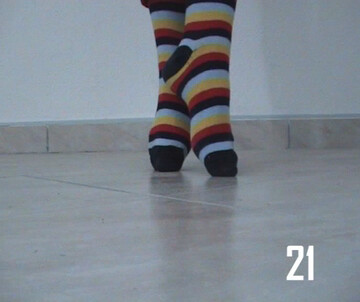27.06.2018 to 02.09.2018
Host: MQ Cultural Tenants
Productive Work - What is it supposed to be?
FREE ENTRY, ART, FILM & DIGITAL CULTURE


Press Tour: Thu, Jun 27, 09:30
Opening: Thu, Jun 27, 19:00
Performance "365 routines" by Artist-in-Residence Nina Kurtela: from 20:30 in the Ovalhalle
DJ-Set by Stefan Geissler at frei_raum Q21 exhibition space
In the exhibition 'Productive Work - What is it supposed to be?', curated by Anamarija Batista and displayed in the frei_raum Q21 exhibition space, the notion of 'productivity' as well as the manifold individual and social ideas surrounding it, is put forward for discussion.
Artists:
Bar du Bois (AUT), Igor Eškinja (HRV), Dušica Dražić (SRB/BEL)*, Tomislav Gotovac (HRV) & Dražen Žarković (HRV), Ana Hušman (HRV)*, Jiří Kovanda (CZE), Nina Kurtela (HRV)* & Hana Erdman (USA), Dariia Kuzmych (UKR/GER)* & Svitlana Selezneva (UKR)*, Christina Lammer (AUT), Tihana Mandušić (HRV)*, Damir Nikšić (BIH), Alicja Rogalska (POL/GBR)* & Łukasz Surowiec (POL)*, Nika Rukavina (HRV)*, Irena Sladoje (BIH)* & Iva Simčić (BIH)*, Borjana Ventzislavova (AUT/BGR), Jakub Vrba (AUT/CZE).
*Q21 Artists-in-Residence
- In today's mainstream economy, productivity is defined as 'the relation between production output and factor input', whereby normally a distinction is made between work productivity, capital productivity and multifactor productivity. Higher productivity is achieved through technological innovation, new business models etc. The exhibition raises questions concerning desires and visions that exist with respect to productivity and associated production conditions in 2018. Should the increase of productivity lead to a shortening of working hours, as John Maynard Keynes predicted would occur by 2030? Or do people today wish for a more relaxed and stress-free working day along with more decision-making power?
'Productive Work' highlights the notion of 'productivity' from diverse perspectives and makes clear that productivity should be discussed in terms of structural and ideological conditions and qualities. For how 'Productivity' is defined is the result of social ideas and convictions.
The artistic works on display present a series of experimental settings. They are imagined as figures of thought, as narratives, which underscore or distort the form of productivity. The exhibition thereby lays focus on four key subjects: productivity in the sense of the representation and measuring of output, productivity in the sense of the control-relationship between human and machine, disorder as the tightening screw of productivity conditions, and productivity in relation to the transformation of social visions and living circumstances.
Thus, in his work 'Golden Fingers of Louvre, 2017', Igor Eškinja displays photographs of the revolving door entrance of the Louvre in Paris, which after a day is densely covered with finger and handprints. These shimmer in various colours when touched by the sunlight, and it would appear that what is touched by the visitors to the museum becomes art itself.
Christina Lammer deals with the relationship between Man and Machine. She had hip surgery and made a silicone impression of the cartilage. This can be seen in the exhibition under the title 'Bone Work'. Christina Lammer's work points to the interchangeability of human body parts. The artificial components are not only copies of body parts; rather, their design already makes the enhancement of body functions possible.
In 2014, Alicja Rogalska & Łukasz Surowiec opened a Tear Shop in Lubin for a few days, where visitors could sell their tear fluid. 3 ml of tears were worth €25. Nearly 200 people visited the shop to proffer their tears. In their video installation 'Tear Dealer', the artists show the production events taking place in the store.
'From Sunrise to Sunset, 2005' presents a working day in the life of the performance artist Tomislav Gotovac. He sleeps in a bed in the middle of Zagreb's main square (Trg Bana Jelačića), he vacuums the street, he eats on a stretch of railway track etc. A second camera shows the reactions of the passing residents who talk about what he is doing here and eventually discuss with the artist himself whether what he is doing is work, or not.
'Seaside' is the title of the work by Dušica Dražić. Her life partner Wim Janssen recounted the following story to the artist: his geography teacher in Antwerp once drew the comparison that the distance from the school to the sea was as long as drawing lines with a pen until it is empty. In her work 'Seaside', Dražić visualises this story, filling 72 A4 sheets with lines. Her work addresses the question of work and leisure. While the school symbolises a place for the production of knowledge and can thus be understood as a place of work, the sea is a symbolic place of leisure. How is the distance between these places measured today? Which means are available for this? And what does one associate with these places?
'Diploma Thesis' is an autobiographical work by Dariia Kuzmych (daughter) and Svitlana Selezneva (mother) and shows what influence social change has on people and their productivity. Svitlana Seleznova completed her art studies after the collapse of the USSR. She started to work as a seamstress to earn money, doing well thanks to the lack of 'high-quality' clothing stores in Kiev. She continually applied the techniques that she employed as a dressmaker to her artistic working practices. The social changes, however, occurred so rapidly that Seleznova constantly had to adapt her two occupations - tailoring and art - to 'new' conditions. Dariia Kuzmych invited her mother to visualise her project 'Diploma Thesis' with her, and, in the context of this collaboration, to reflect on the changes in day-to-day work brought about by social events.
Nika Rukovina's 'Manual for house repairs women' is a handbook for women describing how to repair household appliances. It is still possible to restore appliances back to working order oneself. In view of current developments characterised by the digital age, however, the question arises as to how long this will still be possible. Because of the nature and short life cycles of digital appliances, users have less and less insight into their inner workings.